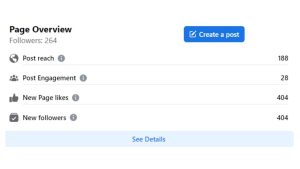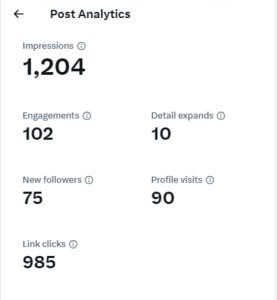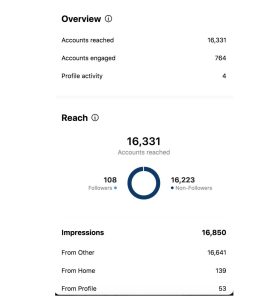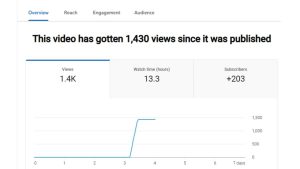
In this dynamic world of social media, understanding the subtle difference between digital marketing buzzwords like reach vs impressions is a must. These terms are often considered one and the same, which couldn’t be farther from the truth.
As a content creator, knowing the difference between these key metrics can help you analyze insights better and craft a profitable marketing strategy. Today, we’re discussing in detail the difference between reach and impressions and why this knowledge is crucial for your upcoming campaign!
Table of Contents
ToggleReach vs Impressions – Definitions
Before getting into the nitty gritty, let us clear some basic definitions first.
- Impressions: This count tells you the number of times your content was seen. Remember, it does not tell you whether the post was clicked or not, it only defines the number of times it popped up on user feeds.
- Reach: This count specifically tells you about the number of users who saw your content. It only includes unique users who actually engaged with the post.
For example: if an Instagram reel was pushed to your feed but you scrolled down without viewing or engaging with it, you’re contributing to 1 impression and 0 reach.
Let us understand reach vs impressions by taking an example of conventional marketing practices. If your sales pamphlets are sent to 1000 houses and only opened by 500 different people, it implies that your impression count is 1000 and your reach is 500. Now, if one house receives 2 pamphlets and a single user reads both of them, impressions are 2 and reach is 1.
Understanding Reach and Impressions in a Greater Detail
Honestly speaking, even after learning the basic definitions of reach vs impressions, getting lost between the actual purpose of both can be tough.
The reach count of any social media post is the total number of users who engaged with the content in any way. It can be due to many reasons, some of them being:
- Clicking on the post, either to enlarge the image or watch the video
- Opening the comment section of the post
- Checking its likes and plays
- Visiting the creator’s profile
On the other hand, impressions are simply counted when any of the posts show up on the feed. Again, it can be due to multiple reasons like:
- Algorithm pushing content to people’s feeds
- Users coming across the post after it’s shared by other people
- Audience searching the hashtag tagged in the post caption
Here, we can conclude that reach and impressions aren’t just limited to your followers. If any person comments on your Facebook post, it will be displayed on their follower’s profile as well. Therefore, it is commonly noticed that a huge chunk of your reach and impression count is not coming from your followers.
Social Media Reach or Impressions – Which is More Important?
Now that you understand what is the difference between reach and impressions, let us see which one is more crucial for you. In a way, both these metrics play a very important role and are contributing to your overall social media growth. However, for different people, there can be different answers.
When Should You Focus on Impressions?
A marketer would need to analyze the campaign’s insights to see whether they are getting any impressions or not. Fewer or no impressions indicate a root-level issue where the ad spend is going to waste. There can be several reasons:
- Your account is shadow-banned due to not complying with official terms and policies
- Your business account is showing a billing program
- Your target audience audience is way too less
When Should You Focus on Reach?
You need to work on optimizing the reach count when you want to study ad analytics. For example, if your ad gets good reach but doesn’t lead to more conversions, it means you need to change the marketing pattern or bring in more offers.
Reach is also important when you are looking for more followers on your account. Doing so will ultimately help improve insights in the long run.
Helpful Reading – How to Go Viral on Instagram: 10 Strategies for Your Brand
Impressions vs. Reach on Different Social Media Platforms
Every social media platform has its own definition of insights. Let’s break some of the popular ones down!
Facebook segregates engagement metrics into three separate categories. To understand Facebook reach vs impressions better, let’s deep dive:
- Organic: When the content is naturally shown to the user in the newsfeed for free.
- Paid: When the user comes across your paid content, like an advertisement.
- Viral: When a user sees the content after it is shared, liked, or commented on by someone else.

Facebook also has separate metrics specifically to measure the performance of ads.
- Served: This count represents the number of times a publisher has told the system to publish the ad.
- Viewed: Total number of times the ad enters the website or application screen of the user.
Served ad count is mostly irrelevant as it doesn’t necessarily tell you that the user viewed or engaged with the ad. It also includes the number of times when the advertisement is displayed at the bottom of the page and the user exits the platform without even reaching it.
On the other hand, the viewed count is more accurate and can be used to understand marketing analytics better.
Twitter (𝕏)
Twitter (𝕏) has simplified the engagement analytics by only offering one key metric, i.e., impressions. 
This begs the question, what is a Twitter impression? This count is the measure of the total times your post is shown in users’ timelines or search results. It also includes the total impacts garnered due to reposts and sharing via messages or links.
However, it doesn’t talk about the impressions due to the usage of any third-party websites or platforms.
Now, Twitter (𝕏) has also started displaying the real impression count below each post. This metric gives you the total number of times a post has been viewed. It also mentions details about link clicks, profile visits, detail expands, and engagements.
Differentiating Instagram reach vs impressions can help you work towards better brand awareness and visibility. Here, key metrics are clubbed into different categories: 
- Reach: unique users who see your posts, reels, videos, or stories.
- Impression: total number of times your post or reel is pushed to user feeds.
- Engagement: when people like, comment, or share the content.
If you’re planning to launch a campaign or start your journey as a creator, you can buy Instagram impressions for the initial boost. You can also get free likes on Instagram and be assured that your posts aren’t going unnoticed in the overflowing sea of content.
Adding an IG call to action will also lead to more reach and impressions.
YouTube
YouTube only lets its users see one metric, i.e., impressions. YouTube impressions tell you how many times the video thumbnail was shown to people. An impression is counted when 50% or more of the thumbnail lasts on a user’s screen for more than a second.

YouTube has different ways of counting and not counting impressions. For example, if your thumbnail is viewed on a desktop website or mobile app, it is considered an impression. However, if a user sees the thumbnail embedded on a third-party platform, mobile website, email, or notifications, it is not counted as an impression.
Conclusion
Digital marketing has various layers. From excelling as a creative genius to being an expert analyst, it takes a lot to get the most out of your campaigns. Understanding the difference between reach and impressions is one such task!
Generally, it takes 5 to 7 impressions for a person to remember a brand. However, for a single user, it only contributes to 1 reach. Tracking reach vs impressions can help you know the frequency, i.e., how many people come across your content repeatedly.
For someone who’s starting as a beginner with not a huge follower count, getting seen on social media, especially Instagram can be hard. But worry not! We’re here to tell you How to Get More Instagram Impressions for Your Posts.
FAQ’s
1. What is better – Reach or Impressions?
Both reach and impressions are crucial from a marketing perspective. Impressions tell you about overall visibility while reach helps you know how many unique users have seen your content.
2. What is the difference between impressions and reach on a story?
Impressions are the total number of times your story has been watched, while reach is the number of different people watching your story. Impressions also count when the same person rewatched the story multiple times.
3. What does it mean when impressions are higher than reach?
When impressions are higher than reach, it can mean two things. Firstly, it might imply that the content is delivered to a lot more people than the ones actually watching it. Secondly, it might also mean that people are rewatching your content repeatedly.
4. What is the difference between clicks and reach?
Reach is the total number of times different people saw your content on their screen. On the other hand, clicks refer to the count of people actually clicking somewhere on the post, whether to pause, enlarge, or engage.
5. Why is my reach on Instagram higher than my views?
Reach can be higher on Instagram than the views when people see your content but scroll past to another post quickly.
6. What is reach vs impressions vs engagement?
Reach is the count of unique users seeing the content, while impressions are the count of total times your content is posted to users’ feeds. Similarly, engagement is the total number of times when people like, share, comment on your post, or click on your profile link.
7. How to increase reach and impressions on Instagram?
To increase reach and impressions on Instagram, you can start by optimizing your profile and using the correct SEO hashtags. You can also invest to buy Instagram auto impressions from buyautolikes.io for a good head start.

Tina caps is the author of BuyAutoLikes, a social media marketing agency that helps brands and influencers grow their followings organically.